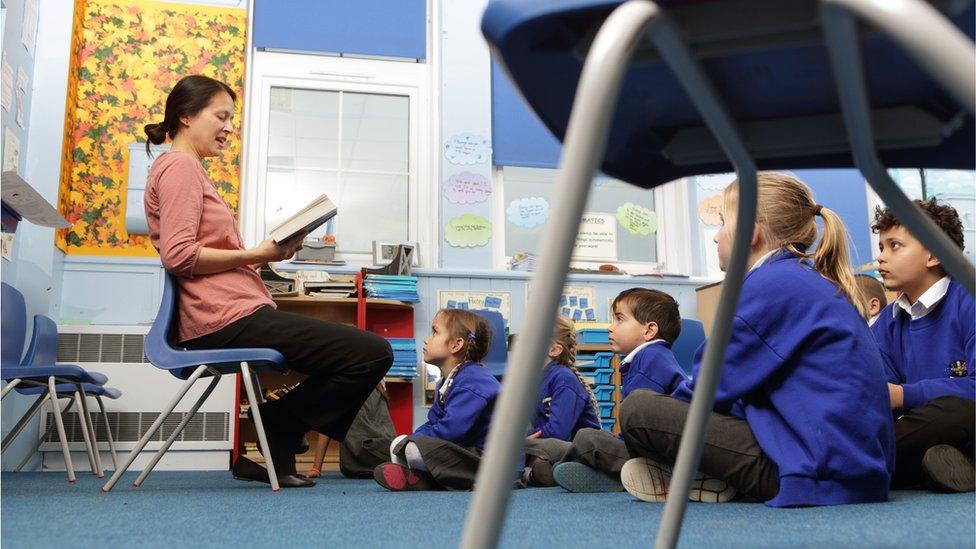Covid: Persistent school absence in Wales shows big jump
- Published

Persistent absence is defined as when a pupil misses more than 20% of available class sessions over the school year.
One in five pupils from poorer backgrounds were persistently absent from school last year.
Figures show 10% of all pupils were persistently absent during the pandemic - the rate was under 3% before that.
The absence gap between pupils eligible for free school meals (FSM) and those who are not grew after Covid, the Welsh government figures suggest.
One teaching union said some pupils were vulnerable to missing school, having disengaged during lockdown.
Persistent absence is when a pupil misses than 20% of classes over the school year.
For the first time, these figures compare the last academic year - when pupils went back to school - with the five years before the pandemic.
They do not include the first year of the pandemic when teaching took place remotely due to the lockdown.

What do the figures show?
About 10% of pupils were persistently absent during the pandemic compared to fewer than 3% before the pandemic
This means about 38,000 pupils are persistently absent
About 21% of pupils eligible for FSM were persistently absent during the pandemic compared to 6% of pupils who did not qualify
This gap was six percentage points before the pandemic but has now grown to 16 percentage points
Almost 22% of year 11 pupils - those in the GCSE exam year - were persistently absent compared to between 5% and 6% before the pandemic
Persistent absence in primary-aged pupils was around 5% but it was around 1.6% on average before the pandemic
When looking at half day school sessions missed, absence for pupils eligible for FSM was about 6.5 percentage points higher than before the pandemic
Boys had a lower absence rate than girls by 0.2 percentage points in 2021-22 a pattern not seen in any of the five years before the pandemic

'Mental health factors'
Eithne Hughes, director of the teaching union ASCL Cymru, said the figures "laid bare" the scale of the disruption faced by schools over the past two years.
"It is unsurprising that children eligible for free school meals were absent more often than their peers during this period. They are more likely to live in urban areas with higher levels of deprivation, places which tended to have the highest Covid rates.
"Some children were particularly vulnerable to missing school, having disengaged during lockdown, and absence has also been caused by mental health factors often impacted by the pandemic.
"Real-terms funding cuts have left fewer pastoral support staff available to intervene and support persistently absent pupils to return to school," Ms Hughes added.
"This is one of many reasons why we need to see a substantial increase in investment in education. It is so vital to improving outcomes for children and young people."
'Incredibly difficult'
In the spring, fixed penalty notices were suggested as a "last resort" to tackle worries over continued absenteeism.
The Welsh government said the last two years had been "incredibly difficult" for many families and it remained mindful of people's concerns.
"However it's vital for young people's wellbeing and education to attend school, seeing their friends, and learning in the classroom," said a spokesperson.
"We have recently provided almost £4m for family engagement officers, to establish positive relationships with parents and provide support and information on good attendance. Schools that know their families well can ensure that measures are put in place to help children maintain good engagement and attendance. "
It said there was also funding for an attendance officer in each local authority to support pupils in year 11 to try to ensure they progressed through their GCSEs.
Meanwhile, the most recent figures on school absenteeism for this academic year show there is still a gap between children from poorer backgrounds and other pupils.
The attendance rate so far has been higher for pupils not eligible for free school meals (93.1%) than pupils who are eligible (86.9%).
In England, persistent absence is defined as missing more than 10% of school.
There, the rate is almost twice as high as before the pandemic.
The Welsh government is reviewing the definition of "persistent" absence, which it regards as an important measure because it is often a trigger for intervention from the likes of the education welfare service.
- Published28 July 2022

- Published3 May 2022

- Published30 September 2022

- Published28 May 2024
